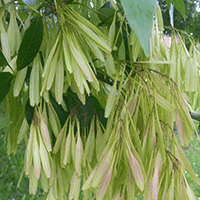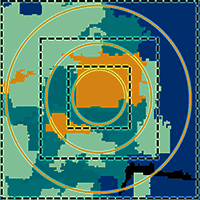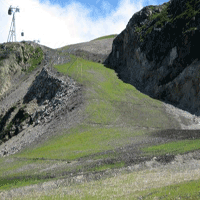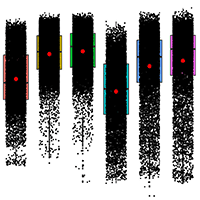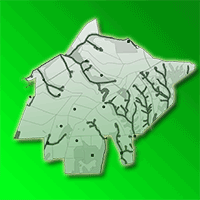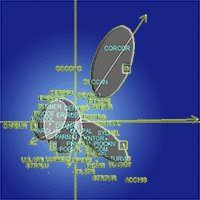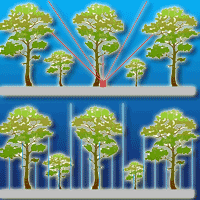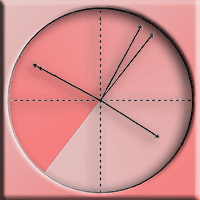
Light availability influences the invasion of Teline monspessulana (L.) K. Koch in a temperate fragmented forest in Central Chile
Persy Gómez (1), Sergio Espinoza (2) , Natalia Cuadros (3), Estefany Goncalves (3), Ramiro Bustamante (3-4)
iForest - Biogeosciences and Forestry, Volume 15, Issue 5, Pages 411-416 (2022)
doi: https://doi.org/10.3832/ifor4026-015
Published: Oct 19, 2022 - Copyright © 2022 SISEF
Research Articles
Abstract
The Maulino forest is a temperate ecosystem of the Mediterranean zone of Chile classified as one of the 34 biodiversity hot-spots of the world; however, there is still limited information about the ecological factors that make this native forest prone to be invaded. We assess to what extent forest attributes such as light availability and native species diversity control the invasion process of Teline monspessulana (L.) K. Koch, an aggressive weed, into the Maulino forest, an endemic forest ecosystem of Central Chile. We examined whether the seedling density of this exotic plant is related to forest attributes such as cover, incoming photosynthetically active radiation, litter depth, and native species density and richness. We found that a decrease of light availability reduces T. monspessulana invasion. No relationships were observed between native species diversity and the abundance of T. monspessulana plants. Increasing the forest cover will recover forest structure but at the same time, it will prevent the invasion of T. monspessulana and other exotic plants with similar regeneration niche requirements.
Keywords
Invasibility, Invasiveness, French Broom, Genista monspessulana, Forest Cover, Native Species Diversity
Authors’ Info
Authors’ address
Facultad de Ciencias Agrarias y Forestales, Universidad Católica del Maule, Avenida San Miguel, 3605, Talca (Chile)
Estefany Goncalves 0000-0002-1066-4519
Ramiro Bustamante 0000-0001-6441-7006
Departamento de Ciencias Ecológicas, Facultad de Ciencias, Universidad de Chile, Santiago (Chile)
Instituto de Ecología y Biodiversidad (IEB), Facultad de Ciencias, Universidad de Chile, Santiago (Chile)
Corresponding author
Paper Info
Citation
Gómez P, Espinoza S, Cuadros N, Goncalves E, Bustamante R (2022). Light availability influences the invasion of Teline monspessulana (L.) K. Koch in a temperate fragmented forest in Central Chile. iForest 15: 411-416. - doi: 10.3832/ifor4026-015
Academic Editor
Rossella Guerrieri
Paper history
Received: Nov 22, 2021
Accepted: Aug 04, 2022
First online: Oct 19, 2022
Publication Date: Oct 31, 2022
Publication Time: 2.53 months
Copyright Information
© SISEF - The Italian Society of Silviculture and Forest Ecology 2022
Open Access
This article is distributed under the terms of the Creative Commons Attribution-Non Commercial 4.0 International (https://creativecommons.org/licenses/by-nc/4.0/), which permits unrestricted use, distribution, and reproduction in any medium, provided you give appropriate credit to the original author(s) and the source, provide a link to the Creative Commons license, and indicate if changes were made.
Web Metrics
Breakdown by View Type
Article Usage
Total Article Views: 25232
(from publication date up to now)
Breakdown by View Type
HTML Page Views: 21761
Abstract Page Views: 1957
PDF Downloads: 1110
Citation/Reference Downloads: 2
XML Downloads: 402
Web Metrics
Days since publication: 1155
Overall contacts: 25232
Avg. contacts per week: 152.92
Citation Metrics
Article Citations
Article citations are based on data periodically collected from the Clarivate Web of Science web site
(last update: Mar 2025)
Total number of cites (since 2022): 2
Average cites per year: 0.50
Publication Metrics
by Dimensions ©
Articles citing this article
List of the papers citing this article based on CrossRef Cited-by.
References
The invasive potential of Genista monspessulana (Montpellier Broom) in dry sclerophyll forest in Victoria. Victorian Naturalist 108: 84-89.
Gscholar
El fuego favorece la invasión de Teline monspessulana (Fabaceae) al aumentar su germinación [Fire promotes Teline monspessulana (Fabaceae) invasion by increasing its germination]. Revista Chilena de Historia Natural 83: 443-452. [in Spanish]
Gscholar
Banco de semillas, regeneración y crecimiento de Teline monspessulana (L.) K. Koch después de un incendio forestal [Seed bank, regeneration and growth of Teline monspessulana (L.) K. Koch after a forest fire]. Gayana Botanica 64: 201-210. [in Spanish]
CrossRef | Gscholar
Estructura poblacional de Teline monspessulana (L.) K. Koch en fragmentos de Bosque Maulino en Chile Central. [Population structure of Teline monspessulana (L.) K. Koch in fragments of the Maulino forest in Central Chile]. Gayana Botanica 69: 197-200. [in Spanish]
CrossRef | Gscholar
Edge-related changes in environment and plant responses due to forest fragmentation in central Amazonia. In: “Tropical Forest Remnants: Ecology, Management, and Conservation ff Fragmented Communities” (Laurance WF, Bierregaard RO eds). University of Chicago Press, Chicago, IL, USA, pp. 33-44.
Gscholar
Hyper-disturbed parks: edge effects and the ecology of isolated reserves in tropical Australia. In: “Tropical Forest Remnants: Ecology, Management, and Conservation ff Fragmented Communities” (Laurance WF, Bierregaard RO eds). University of Chicago Press, Chicago, IL, USA, pp. 71-84.
Gscholar
Invasion ecology. Blackwell Publishing, Malden, UK, pp. 428.
Gscholar
Manual de las malezas que crecen en Chile [Chilean weeds manual]. Editorial Universidad de Concepción, Concepción, Chile, pp. 545. [in Spanish]
Gscholar
The invasions of plants and animals into California. In: “Ecology of Biological Invasions of North America and Hawaii” (Billings WD, Golley F, Lange OL, Olson JS, Remmert H, Mooney HA, Drake JA eds). Series Ecological Studies, vol. 58, Springer, New York, NY, pp. 250-272.
Gscholar
Fragmentación progresiva y pérdida de hábitat de bosques naturales en uno de los hotspot mundiales de biodiversidad [Progressive fragmentation and loss of forest habitat in a world biodiversity hot-spot]. Revista Mexicana de Biodiversidad 88: 924-935. [in Spanish]
CrossRef | Gscholar
Estructura florística e impacto antrópico en el bosque maulino de Chile [Floristic structure and anthropic impact in the Chilean Maulino forest]. In: “Ecología de los Bosques Nativos de Chile” (Armesto JJ, Villagrán C, Arroyo KM eds). Universitaria, Santiago, Chile, pp. 153-168. [in Spanish]
Gscholar
Introduction: the value of forest patches. In: “Forest Patches in Tropical Landscapes” (Schelhas J, Greenberg R eds). Island Press, Washington, USA, pp. 15-34.
Gscholar
Patrón de regeneración de la plántula de Genista monspessulana (I.) LAS Johnson, en dos escenarios de restauración ecológica [Pattern of regeneration of Genista monspessulana (I.) LAS Johnson under two scenarios of ecological restoration]. Colombiana Forestal 20: 131-143. [in Spanish]
CrossRef | Gscholar
Severidad del daño causado por los incendios forestales en los bosques remanentes de Nothofagus alessandrii Espinosa en la Región del Maule de Chile [Fire severity damages caused on Nothofagus alessandrii forest on the Maule Region of Chile]. Gayana Botanica 75: 531-534. [in Spanish]
CrossRef | Gscholar
Dynamics and restoration of forest fragments in Brazilian Atlantic moist forest. In: “Tropical Forest Remnants: Ecology, Management, and Conservation of Fragmented Communities” (Laurance WF, Bierregaard RO eds). University of Chicago Press, Chicago, USA, pp. 351-365.
Gscholar


